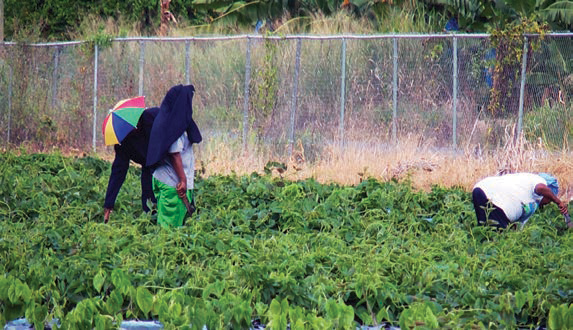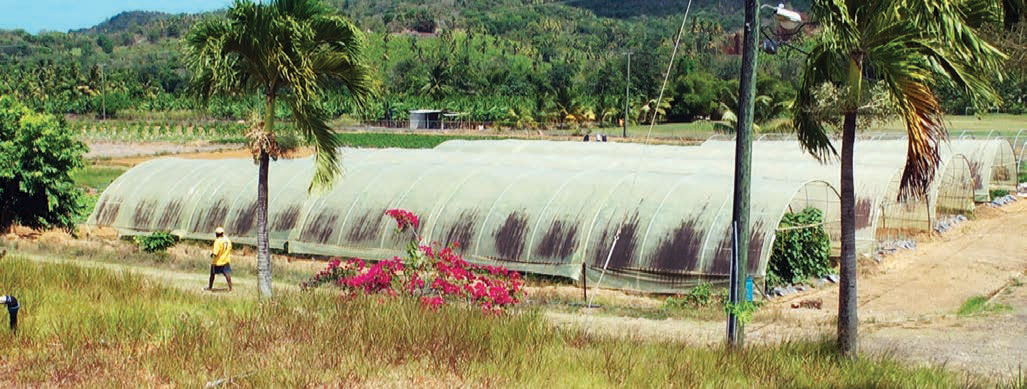
ATP-BAM
OverviewTHE SFA PROGRAMME
With the erosion of preferential trading arrangements sometime around 1999, the European Union (EU) conceptualized the Special Framework of Assistance or SFA Programme to help small economies in the African,
Caribbean and Pacific (ACP) States cope with the fallout. The 10-year SFA Programme funded by the European
Commission was to help diversify the agricultural sector in ACP countries.
ATP/BAM
Special Projects Coordinator in the Ministry of Agriculture, Eden Compton, disclosed that the Agricultural Transformation Programme (ATP) of which the Banana Accompanying Measures (BAM) is a major component – is intended to build on the gains made by the SFAs. He explained: “This instrument (ATP/BAM) is intended to continue agricultural modernization, transformation and diversification, but this time in countries which have exported more than 10,000 tons of bananas to the United Kingdom or to the European Union over the last 10 to 12 years.”

BENEFICIARY COUNTRIES
The beneficiary countries of the EU-funded ATP/BAM are Suriname, St. Vincent and the Grenadines, St. Lucia, Dominica, Jamaica, Belize and the Dominican Republic in our Hemisphere. On the African continent, the countries receiving assistance are Cameroon, Ghana and the Ivory Coast. The EU-funded Agricultural Transformation Programme is also designed to help integrate the economies of beneficiary countries into the global economy.

NATIONAL ADAPTATION STRATEGY
Each beneficiary country developed a National Adaptation Strategy based on a diagnosis of the needs of its agricultural sector. The next stage was the development of a Multi-annual Support Strategy to address priority areas in the National Adaptation Strategy. St. Lucia’s National Adaptation Strategy has four (4) main components.
The first component is Agri-Enterprise Facilitation through Market Development and Agro Processing in order to leverage expansion of the value chain. A key objective is to enhance the value of selected agricultural commodities to meet the demands of the market. Agricultural commodities identified under the BAM include Food and Root Crops, Vegetables and Herbs, Fruit and Tree Crops, and Livestock. Livestock covers egg production, broiler production, pig farming, and ruminants (goats and sheep). The ATP/BAM supports open field as well as greenhouse production, irrigation, land/soil preparation, and the adaptation of new technologies in agriculture.
Read More
Training of Agro Processors and Extension Officers (Crops and Livestock) is a critical element of this component of the ATP/BAM. The Training for Agro Processors focuses primarily on Business and Entrepreneurial Development whilst the Training for Extension Officers Focuses on Value Chain Analysis of the targeted commodities. The retrofitting of agro processing facilities also forms part of this component. Four agro processing facilities on the island are earmarked for upgrades. They are the Fond Assau Agro Processing Plant, a Facility for Rural Women Agro Processors in Anse Ger, the Cocoa Micro-Fermentary in Anse Ger (built under SFA 2005) and a Processing and Bottling Facility for Mille Fleurs Honey Producers at the La Caye IRDC in collaboration with the Global Environment Fund (GEF) and the Trade Export Promotion Agency (TEPA)
The second component of the National Adaptation Strategy involves facilitation of Research and Technology in Agriculture through the construction of a National Diagnostic Facility at Union, which will monitor Plant and Animal Health, Soil Testing, Tissue Culture Analysis, as well as Food Safety Monitoring, and Enforcement of Safety Standards and Protocols with oversight by the Saint Lucia Bureau of Standards.
The third component is Disaster Risk Reduction in Agriculture through the continued implementation of a management plan for the Black Sigatoka disease which has adversely affected the island’s banana crop. This involves the establishment of the Black Sigatoka Management Unit and implementation of the Black Sigatoka Management Project. Compton underscored the high cost of managing Black Sigatoka and the consequences of not managing the disease for the banana industry and St. Lucia’s economy as a whole.
The Rehabilitation of Farm Community Infrastructure is yet another element of the Disaster Risk Reduction component. Initially, the Ministry focused on Drainage and Riverbank Stabilization. In light of extensive damage to the road network in farming communities, the next phase will focus heavily on Rehabilitation of Farm Roads, commonly referred to as Feeder Roads.
NURTURING A NEW CROP OF FARMERS
The fourth component of the National Adaptation Strategy for St. Lucia’s Agriculture Sector is Youth Agri-Enterprise Facilitation also known as the Youth Agricultural Entrepreneurial Project (YAEP). The YAEP seeks to create an enabling environment that will allow the entry of approximately 150 young persons in Agriculture as young entrepreneurs. The objective is to create a new crop of farmers. The YAEP is also an incubator programme designed to accelerate the pace at which St. Lucia’s agricultural sector is modernized, transformed and diversified.
The YAEP targets unemployed, employed and under-employed persons within rural communities. Under the YAEP, 205 acres of land have been earmarked for the cultivation of specific crops and the rearing of livestock. The Ministry of Agriculture is collaborating with Invest Saint Lucia and the Department of Crown Lands in this initiative. Land has been identified in the Roseau Valley, River Doree in Choiseul, Beausejour in Vieux Fort and the Mabouya Valley in Dennery. These lands will be subdivided and leased to young persons, mainly between the ages of 18 – 35 but not limited to that age group.
Read More
A Committee has been established to manage the distribution of the lands. One local and one overseas supplier have been selected to supply equipment and impliments for the YAEP. Most of the equipment and impliments are already on island. There will be a Storage and Distribution Facility at Beausejour in Vieux Fort and one in the Mabouya Valley. Production Schedules have been drafted for all the crops to be produced as well as for broiler production. The Production Schedule for Swine (pig farming) is being prepared by the Veterinary & Livestock Division of the Ministry of Agriculture. The Special Projects Unit is working very closely with the National Skills Development Centre (NSDC) to undertake Refresher Training for young farmers registered under the YAEP. Compton disclosed that production and output under the YAEP will be prescribed and monitored and the selected young farmers will not be left on their own to produce “what they want, when they want.”
He explained: “The focus here is on import substitution… looking at the agricultural commodities that we import that we can produce locally. At present, our local farmers produce too much of the same crops at the same time; so the price goes down and they find themselves at a loss. Under the YAEP, there will be Production Scheduling for both Crops and Livestock, so that production will coincide with demand. This will assist in cutting our Annual Food Import Bill, which stands at somewhere in the vicinity of $360 million.” Compton hastened to add that St. Lucia cannot produce all commodities “so we have to be selective and focus on the commodities we can do best – both in terms of primary production and value-added activities.”

MAKING THE TRANSITION
The overall value of the ATP/BAM for St. Lucia is 10.3 million euros or approximately EC$35 million. Compton explained that the transition from a mono crop culture to a diversified agricultural sector has not been easy. He explained: “We’re coming from an era where banana production was the predominant agricultural activity in St. Lucia. Banana farmers capitalized on a guaranteed preferential market for our bananas in the United Kingdom. St. Lucia was the largest producer of bananas in the Windward Islands. All other agricultural commodities were sidelined in the heyday of bananas. The transition has been difficult because there is still this ‘romance’ with bananas, but I think our farmers are beginning to realize that we have to move away from bananas. That is why the Ministry is hoping that the ATP/BAM will accelerate the pace of diversification, transformation and modernization of agriculture in St. Lucia.”
To underscore the potential of non-traditional sectors of the agriculture industry, Compton disclosed that in 2013 purchases of local chicken amounted to $19 million in revenue. St. Lucia’s current banana exports average $20 million per annum. Compton believes such statistics make a compelling case for Government to develop emerging sectors within the agriculture industry and that’s exactly what the BAM is intended to achieve.

